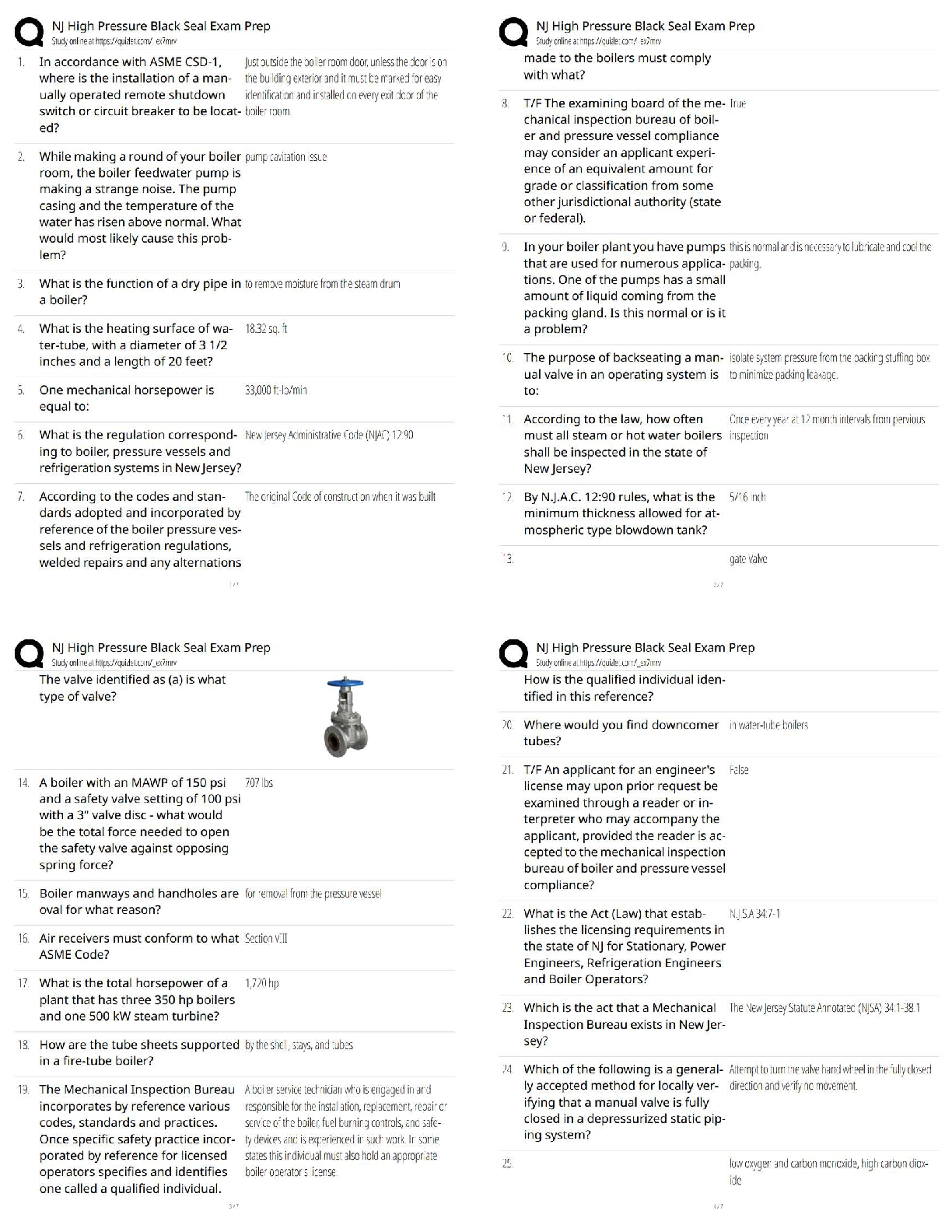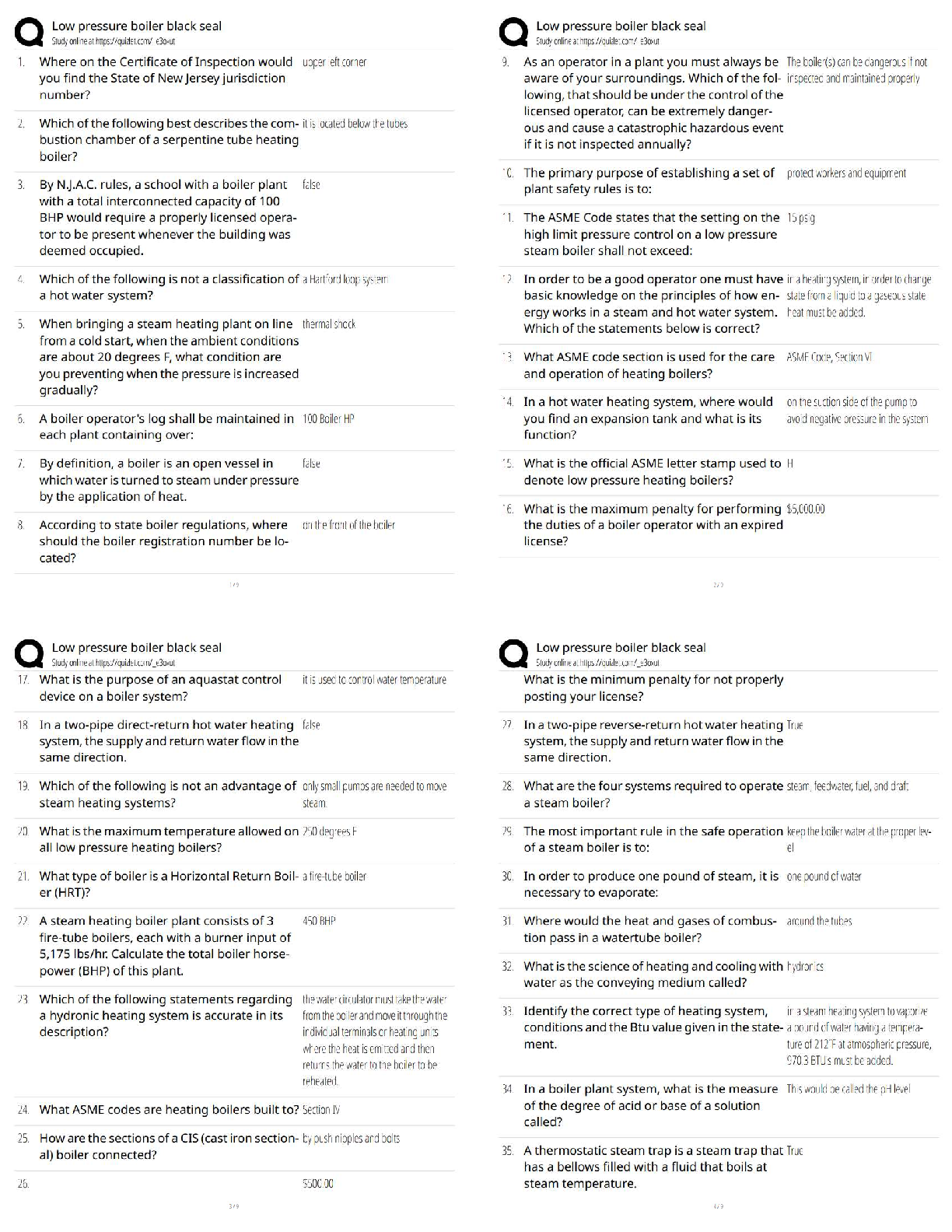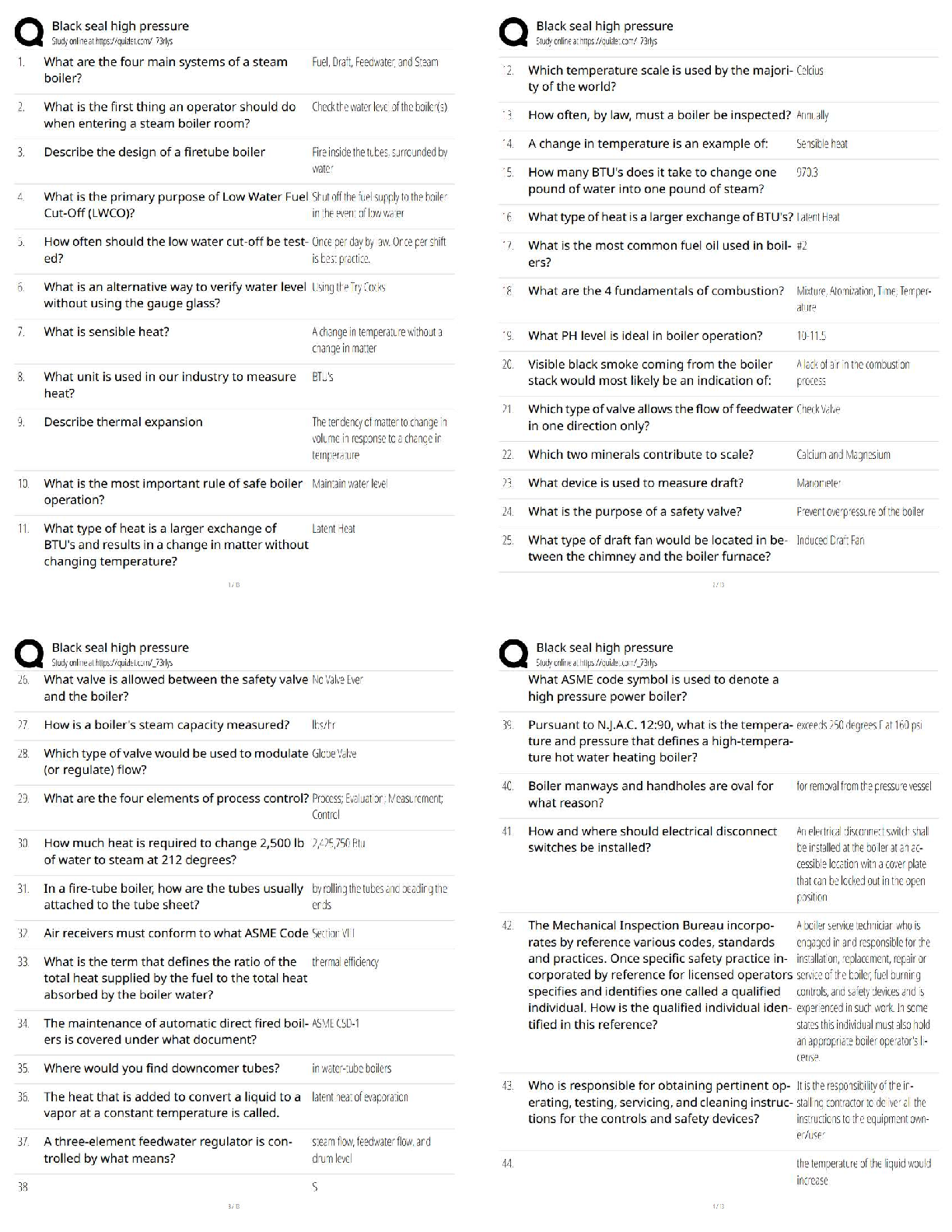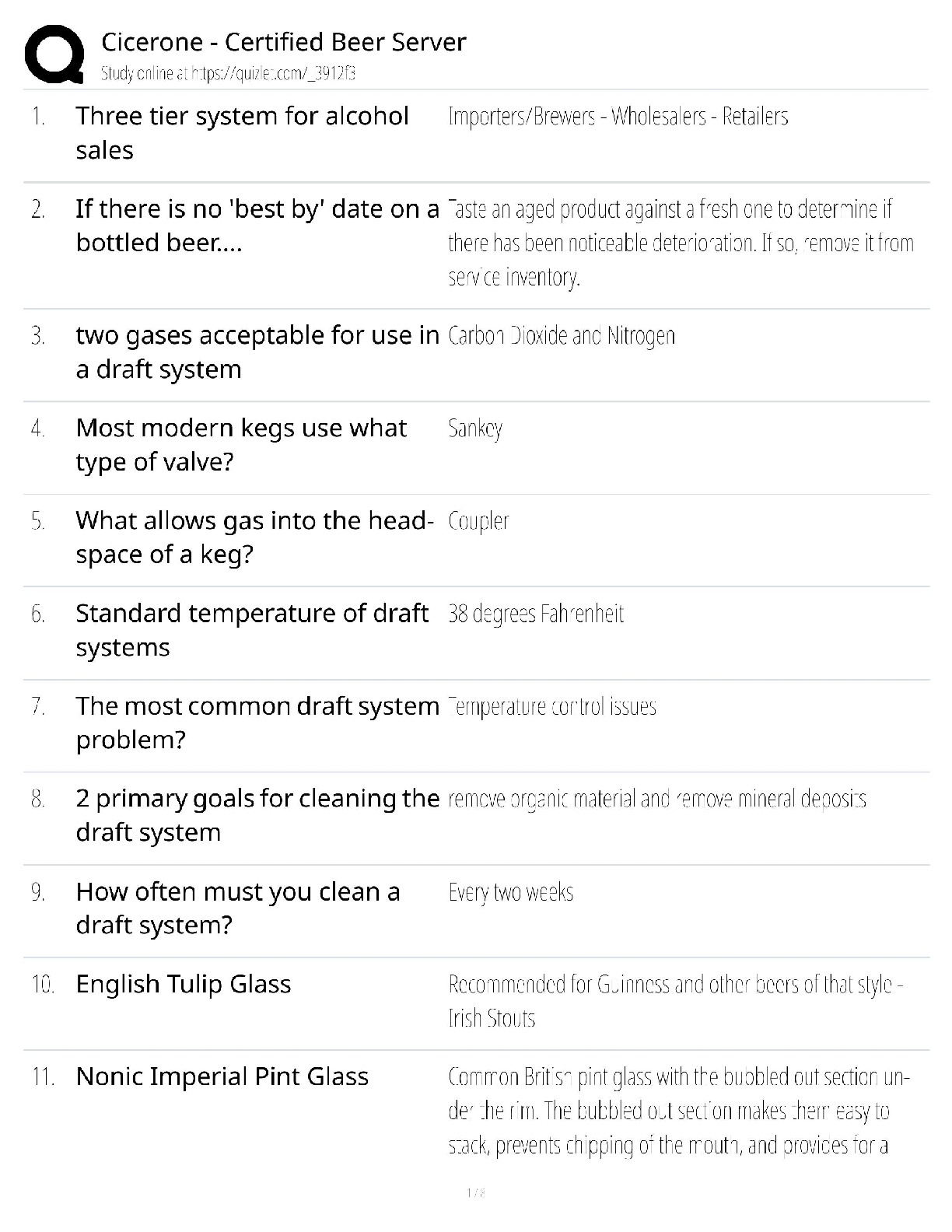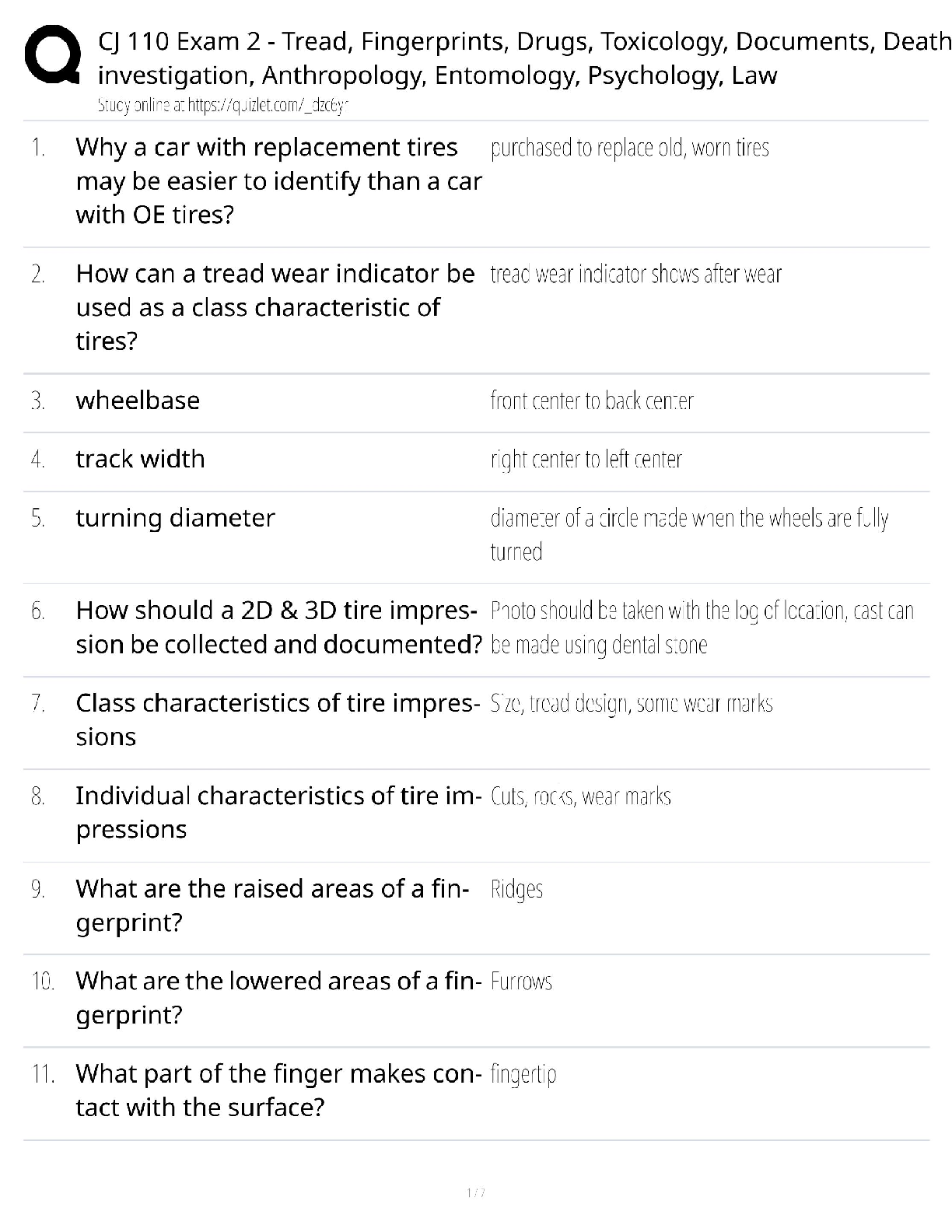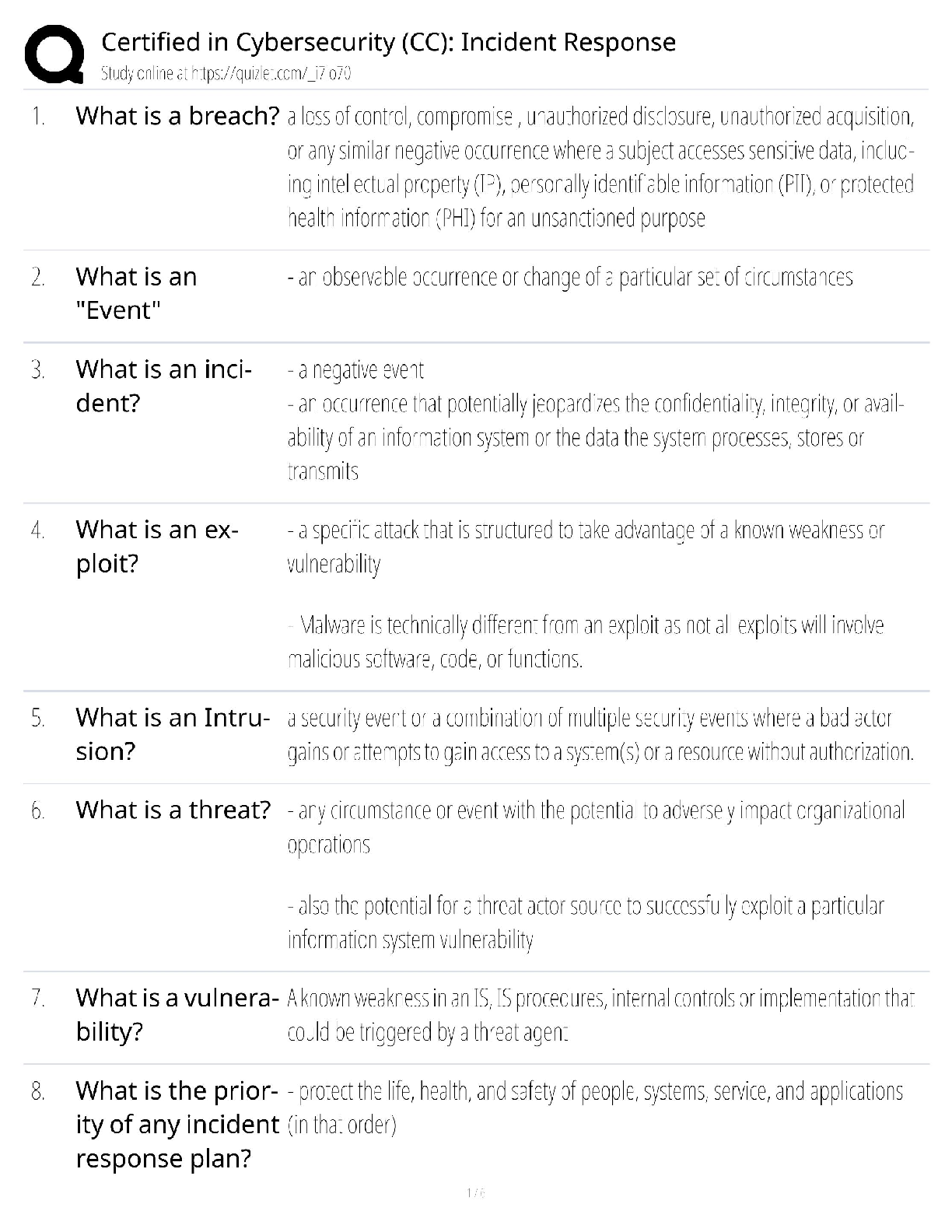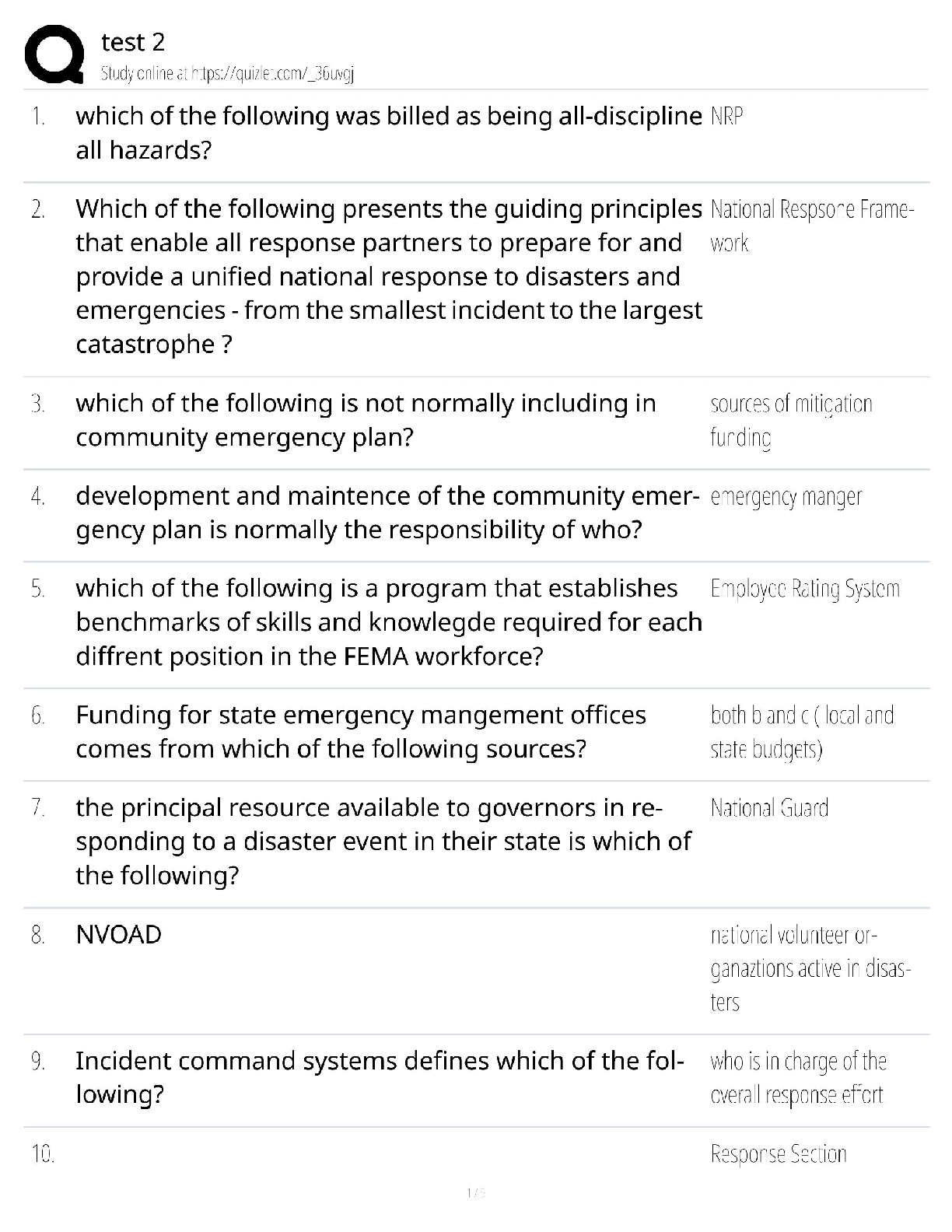*NURSING > QUESTIONS & ANSWERS > NURSING 01 (SOLVED MCQ) Chapter 25: The Child with Cardiovascular Dysfunction (All)
NURSING 01 (SOLVED MCQ) Chapter 25: The Child with Cardiovascular Dysfunction
Document Content and Description Below
Chapter 25: The Child with Cardiovascular Dysfunction MULTIPLE CHOICE 1. A chest radiograph film is ordered for a child with suspected cardiac problems. The child’s parent asks the nurse, “What ... will the radiograph show about the heart?” The nurse’s response should be based on knowledge that the x-ray film will show: a. bones of chest but not the heart. b. measurement of electrical potential generated from heart muscle. c. permanent record of heart size and configuration. d. computerized image of heart vessels and tissues. ANS: C A chest radiograph will provide information on the heart size and pulmonary blood-flow patterns. It will provide a baseline for future comparisons. The heart will be visible, as well as the sternum and ribs. Electrocardiography (ECG) measures the electrical potential generated from heart muscle. Echocardiography will produce a computerized image of the heart vessels and tissues by using sound waves. PTS: 1 DIF: Cognitive Level: Understand REF: 835 TOP: Integrated Process: Teaching/Learning MSC: Area of Client Needs: Physiologic Integrity: Reduction of Risk Potential 2. The nurse is assessing a child after a cardiac catheterization. Which complication should the nurse be assessing for? a. Cardiac arrhythmia b. Hypostatic pneumonia c. Heart failure d. Rapidly increasing blood pressure ANS: A Because a catheter is introduced into the heart, a risk exists of catheter-induced dysrhythmias occurring during the procedure. These are usually transient. Hypostatic pneumonia, heart failure, and rapidly increasing blood pressure are not risks usually associated with cardiac catheterization. PTS: 1 DIF: Cognitive Level: Apply REF: 853 TOP: Integrated Process: Nursing Process: Assessment MSC: Area of Client Needs: Physiologic Integrity: Reduction of Risk Potential 3. José is a 4-year-old child scheduled for a cardiac catheterization. Preoperative teaching should be: a. directed at his parents because he is too young to understand. b. c. detailed in regard to the actual procedures so he will know what to expect. done several days before the procedure so that he will be prepared. d. adapted to his level of development so that he can understand. ANS: DPreoperative teaching should always be directed at the child’s stage of development. The caregivers also benefit from the same explanations. The parents may ask additional questions, which should be answered, but the child needs to receive the information based on developmental level. Preschoolers will not understand in-depth descriptions and should be prepared close to the time of the cardiac catheterization. PTS: 1 DIF: Cognitive Level: Apply TOP: Integrated Process: Teaching/Learning MSC: Area of Client Needs: Health Promotion and Maintenance 4. Which explanation regarding cardiac catheterization is appropriate for a preschool child? a. Postural drainage will be performed every 4 to 6 hours after the test. b. It is necessary to be completely “asleep” during the test. c. The test is short, usually taking less than 1 hour. d. When the procedure is done, you will have to keep your leg straight for at least 4 hours. ANS: D The child’s leg will have to be maintained in a straight position for approximately 4 hours. Younger children can be held in the parent’s lap with the leg maintained in the correct position. Postural drainage will not be performed unless the child has corresponding pulmonary problems. The child should be sedated to lie still, but being completely asleep is not necessary. The test will vary in length of time from start to finish. PTS: 1 DIF: Cognitive Level: Apply TOP: Integrated Process: Teaching/Learning MSC: Area of Client Needs: Health Promotion and Maintenance 5. The nurse is caring for a school-age child who has had a cardiac catheterization. The child tells the nurse that the bandage is “too wet.” The nurse finds the bandage and bed soaked with blood. The most appropriate initial nursing action is to: a. notify physician. b. apply new bandage with more pressure. c. place the child in Trendelenburg position. d. apply direct pressure above catheterization site. ANS: D If bleeding occurs, direct continuous pressure is applied 2.5 cm (1 inch) above the percutaneous skin site to localize pressure over the vessel puncture. Notifying a physician and applying a new bandage can be done after pressure is applied. The nurse can have someone else notify the physician while the pressure is being maintained. It is not a helpful intervention to place the girl in the Trendelenburg position. It would increase the drainage from the lower extremities. PTS: 1 DIF: Cognitive Level: Apply REF: 823 TOP: Integrated Process: Nursing Process: Implementation MSC: Area of Client Needs: Physiologic Integrity: Physiologic Adaptation 6. The nurse is preparing an adolescent for discharge after a cardiac catheterization. Which statement by the adolescent would indicate a need for further teaching? REF: 823 REF: 822a. b. c. “I should avoid tub baths but may shower.” “I have to stay on strict bed rest for 3 days.” “I should remove the pressure dressing the day after the procedure.” d. “I may attend school but should avoid exercise for several days.” ANS: B The child does not need to be on strict bed rest for 3 days. Showers are recommended; children should avoid a tub bath. The pressure dressing is removed the day after the catheterization and replaced by an adhesive bandage to keep the area clean. Strenuous activity must be avoided for several days, but the child can return to school. PTS: 1 DIF: Cognitive Level: Analyze REF: 823 TOP: Integrated Process: Teaching/Learning MSC: Area of Client Needs: Physiologic Integrity: Reduction of Risk Potential 7. Surgical closure of the ductus arteriosus would: a. stop the loss of unoxygenated blood to the systemic circulation. b. decrease the edema in legs and feet. c. increase the oxygenation of blood. d. prevent the return of oxygenated blood to the lungs. ANS: D The ductus arteriosus allows blood to flow from the higher-pressure aorta to the lower- pressure pulmonary artery, causing a right-to-left shunt. If this is surgically closed, no additional oxygenated blood (from the aorta) will return to the lungs through the pulmonary artery. The aorta carries oxygenated blood to the systemic circulation. Because of the higher pressure in the aorta, blood is shunted into the pulmonary artery and the pulmonary circulation. Edema in the legs and feet is usually a sign of heart failure. This repair would not directly affect the edema. Increasing the oxygenation of blood would not interfere with the return of oxygenated blood to the lungs. PTS: 1 DIF: Cognitive Level: Analyze REF: 825 TOP: Integrated Process: Nursing Process: Planning MSC: Area of Client Needs: Physiologic Integrity: Physiologic Adaptation 8. Which defect results in increased pulmonary blood flow? a. Pulmonic stenosis b. Tricuspid atresia c. Atrial septal defect d. Transposition of the great arteries ANS: C Atrial septal defect results in increased pulmonary blood flow. Blood flows from the left atrium (higher pressure) into the right atrium (lower pressure) and then to the lungs via the pulmonary artery. Pulmonic stenosis is an obstruction to blood flowing from the ventricles. Tricuspid atresia results in decreased pulmonary blood flow. Transposition of the great arteries results in mixed blood flow. PTS: 1 DIF: Cognitive Level: Understand REF: 825 TOP: Integrated Process: Nursing Process: Assessment MSC: Area of Client Needs: Physiologic Integrity: Physiologic Adaptation9. The nurse is conducting a staff in-service on congenital heart defects. Which structural defect constitutes tetralogy of Fallot? a. Pulmonic stenosis, ventricular septal defect, overriding aorta, right ventricular hypertrophy b. Aortic stenosis, ventricular septal defect, overriding aorta, right ventricular hypertrophy c. Aortic stenosis, atrial septal defect, overriding aorta, left ventricular hypertrophy d. Pulmonic stenosis, ventricular septal defect, aortic hypertrophy, left ventricular hypertrophy ANS: A Tetralogy of Fallot has these four characteristics: pulmonic stenosis, ventricular septal defect, overriding aorta, and right ventricular hypertrophy. There is pulmonic stenosis but not atrial stenosis in tetralogy of Fallot. Right ventricular hypertrophy, not left ventricular hypertrophy, is present in tetralogy of Fallot. Tetralogy of Fallot has right ventricular hypertrophy, not left ventricular hypertrophy, and an atrial septal defect, not aortic hypertrophy. PTS: 1 DIF: Cognitive Level: Understand REF: 830 TOP: Integrated Process: Nursing Process: Assessment MSC: Area of Client Needs: Physiologic Integrity: Physiologic Adaptation 10. A nurse is teaching nursing students the physiology of congenital heart defects. Which defect results in decreased pulmonary blood flow? a. Atrial septal defect b. Tetralogy of Fallot c. Ventricular septal defect d. Patent ductus arteriosus ANS: B Tetralogy of Fallot results in decreased blood flow to the lungs. The pulmonic stenosis increases the pressure in the right ventricle, causing the blood to go from right to left across the ventricular septal defect. Atrial and ventricular septal defects and patent ductus arteriosus result in increased pulmonary blood flow. PTS: 1 DIF: Cognitive Level: Understand REF: 830 TOP: Integrated Process: Nursing Process: Assessment MSC: Area of Client Needs: Physiologic Integrity: Physiologic Adaptation 11. Which is best described as the inability of the heart to pump an adequate amount of blood to the systemic circulation at normal filling pressures? a. Pulmonary congestion b. Congenital heart defect c. Heart failure d. Systemic venous congestion ANS: C The definition of heart failure is the inability of the heart to pump an adequate amount of blood to the systemic circulation at normal filling pressures to meet the body’s metabolic demands. Pulmonary congestion is an excessive accumulation of fluid in the lungs. Congenital heart defect is a malformation of the heart present at birth. Systemic venous congestion is an excessive accumulation of fluid in the systemic vasculature.PTS: 1 DIF: Cognitive Level: Understand REF: 830 TOP: Integrated Process: Nursing Process: Assessment MSC: Area of Client Needs: Physiologic Integrity: Physiologic Adaptation 12. Which is a clinical manifestation of the systemic venous congestion that can occur with heart failure? a. Tachypnea b. Tachycardia c. Peripheral edema d. Pale, cool extremities ANS: C Peripheral edema, especially periorbital edema, is a clinical manifestation of systemic venous congestion. Tachypnea is a manifestation of pulmonary congestion. Tachycardia and pale, cool extremities are clinical manifestations of impaired myocardial function. PTS: 1 DIF: Cognitive Level: Understand REF: 835 TOP: Integrated Process: Nursing Process: Assessment MSC: Area of Client Needs: Physiologic Integrity: Physiologic Adaptation 13. The nurse is preparing to administer a dose of digoxin (Lanoxin) to a child in heart failure (HF). Which is a beneficial effect of administering digoxin (Lanoxin)? a. It decreases edema. b. c. It decreases cardiac output. It increases heart size. d. It increases venous pressure. ANS: A Digoxin has a rapid onset and is useful for increasing cardiac output, decreasing venous pressure, and, as a result, decreasing edema. Cardiac output is increased by digoxin. Heart size and venous pressure are decreased by digoxin. PTS: 1 DIF: Cognitive Level: Understand REF: 835 TOP: Integrated Process: Nursing Process: Implementation MSC: Area of Client Needs: Physiologic Integrity: Pharmacologic and Parenteral Therapy 14. A nurse is preparing to administer an angiotensin-converting enzyme (ACE) inhibitor. Which drug should the nurse be administering? a. Captopril (Capoten) b. Furosemide (Lasix) c. Spironolactone (Aldactone) d. Chlorothiazide (Diuril) ANS: A Captopril is an ACE inhibitor. Furosemide is a loop diuretic. Spironolactone blocks the action of aldosterone. Chlorothiazide works on the distal tubules. PTS: 1 DIF: Cognitive Level: Remember REF: 835 TOP: Integrated Process: Nursing Process: Implementation MSC: Area of Client Needs: Physiologic Integrity: Pharmacologic and Parenteral Therapy15. An 8-year-old child is receiving digoxin (Lanoxin). The nurse should notify the practitioner and withhold the medication if the apical pulse is less than _____ beats/min. a. 60 b. c. 70 90 d. 100 ANS: B If a 1-minute apical pulse is less than 70 beats/min for an older child, the digoxin is withheld; 60 beats/min is the cut-off for holding the digoxin dose in an adult. A pulse below 90 to 110 beats/min is the determination for not giving a digoxin dose to infants and young children. PTS: 1 DIF: Cognitive Level: Apply REF: 836 TOP: Integrated Process: Nursing Process: Assessment MSC: Area of Client Needs: Physiologic Integrity: Pharmacologic and Parenteral Therapy 16. A 6-month-old infant is receiving digoxin (Lanoxin). The nurse should notify the practitioner and withhold the medication if the apical pulse is less than _____ beats/min. a. 60 b. c. 70 90 to 110 d. 110 to 120 ANS: C If the 1-minute apical pulse is below 90 to 110 beats/min, the digoxin should not be given to a 6-month-old. 60 beats/min is the cut-off for holding the digoxin dose in an adult. 70 beats/min is the determining heart rate to hold a dose of digoxin for an older child. 110 to 120 beats/min is an acceptable heart rate to administer digoxin to a 6-month-old. PTS: 1 DIF: Cognitive Level: Apply REF: 836 TOP: Integrated Process: Nursing Process: Implementation MSC: Area of Client Needs: Physiologic Integrity: Pharmacologic and Parenteral Therapy 17. The nurse is teaching parents about signs of digoxin (Lanoxin) toxicity. Which is a common sign of digoxin toxicity? a. Seizures b. Vomiting Bradypnea c. d. Tachycardia ANS: B Vomiting is a common sign of digoxin toxicity. Seizures are not associated with digoxin toxicity. The child will have a slower heart rate, not respiratory rate. The heart rate will be slower, not faster. PTS: 1 DIF: Cognitive Level: Understand REF: 839 TOP: Integrated Process: Teaching/Learning MSC: Area of Client Needs: Physiologic Integrity: Pharmacologic and Parenteral Therapy 18. The parents of a young child with heart failure tell the nurse that they are “nervous” about giving digoxin (Lanoxin). The nurse’s response should be based on which statement? a. It is a safe, frequently used drug.b. c. It is difficult to either overmedicate or undermedicate with digoxin. Parents lack the expertise necessary to administer digoxin. d. Parents must learn specific, important guidelines for administration of digoxin. ANS: D Digoxin has a narrow therapeutic range. The margin of safety between therapeutic, toxic, and lethal doses is very small. Specific guidelines are available for parents to learn how to administer the drug safely and to monitor for side effects. Digoxin is a frequently used drug, but it has a narrow therapeutic range. Small amounts of the liquid are given to infants, making it easy to overmedicate or undermedicate. Parents may lack the necessary expertise to administer the drug at first, but with discharge preparation, they should be prepared to administer the drug safely. PTS: 1 DIF: Cognitive Level: Apply REF: 839 TOP: Integrated Process: Teaching/Learning MSC: Area of Client Needs: Physiologic Integrity: Pharmacologic and Parenteral Therapy 19. The nurse is talking to a parent of an infant with heart failure about feeding the infant. Which statement about feeding the child is correct? a. “You may need to increase the caloric density of your infant’s formula.” b. c. “You should feed your baby every 2 hours.” “You may need to increase the amount of formula your infant eats with each feeding.” d. “You should place a nasal oxygen cannula on your infant during and after each feeding.” ANS: A The metabolic rate of infants with heart failure is greater because of poor cardiac function and increased heart and respiratory rates. Their caloric needs are greater than those of the average infants, yet their ability to take in the calories is diminished by their fatigue. Infants with heart failure should be fed every 3 hours; a 2-hour schedule does not allow for enough rest, and a 4- hour schedule is too long. Fluids must be carefully monitored because of the heart failure. Infants do not require supplemental oxygen with feedings. PTS: 1 DIF: Cognitive Level: Apply REF: 838-839 TOP: Integrated Process: Nursing Process: Planning MSC: Area of Client Needs: Physiologic Integrity: Physiologic Adaptation 20. As part of the treatment for heart failure, the child takes the diuretic furosemide (Lasix). As part of teaching home care, the nurse encourages the family to give the child foods such as bananas, oranges, and leafy vegetables. These foods are recommended because they are high in: a. chlorides. b. potassium. c. sodium. d. vitamins. ANS: B Diuretics that work on the proximal and distal renal tubules contribute to increased losses of potassium. The child’s diet should be supplemented with this electrolyte. With this type of diuretic, potassium must be monitored and supplemented as needed.PTS: 1 DIF: Cognitive Level: Understand REF: 840 TOP: Integrated Process: Teaching/Learning MSC: Area of Client Needs: Physiologic Integrity: Pharmacologic and Parenteral Therapy 21. An 8-month-old infant has a hypercyanotic spell while blood is being drawn. The nurse’s first action should be to: a. assess for neurologic defects. b. place the child in the knee-chest position. c. begin cardiopulmonary resuscitation. d. prepare family for imminent death. ANS: B The first action is to place the infant in the knee-chest position. Blow-by oxygen may be indicated. Neurologic defects are unlikely. The child should be assessed for airway, breathing, and circulation. Often, calming the child and administering oxygen and morphine can alleviate the hypercyanotic spell. PTS: 1 DIF: Cognitive Level: Apply REF: 841-842 TOP: Integrated Process: Nursing Process: Implementation MSC: Area of Client Needs: Physiologic Integrity: Physiologic Adaptation 22. The nurse is caring for a child with persistent hypoxia secondary to a cardiac defect. The nurse recognizes that a risk exists of cerebrovascular accidents (strokes). Which is an important objective to decrease this risk? a. Minimize seizures. b. Prevent dehydration. c. Promote cardiac output. d. Reduce energy expenditure. ANS: B In children with persistent hypoxia, polycythemia develops. Dehydration must be prevented in hypoxemic children because it potentiates the risk of strokes. Minimizing seizures, promoting cardiac output, and reducing energy expenditure will not reduce the risk of cerebrovascular accidents. PTS: 1 DIF: Cognitive Level: Analyze REF: 841 TOP: Integrated Process: Nursing Process: Implementation MSC: Area of Client Needs: Physiologic Integrity: Physiologic Adaptation 23. Parents of a 3-year-old child with congenital heart disease are afraid to let their child play with other children because of possible overexertion. The nurse’s reply should be based on which statement? a. Child needs opportunities to play with peers. b. c. Child needs to understand that peers’ activities are too strenuous. Parents can meet all of the child’s needs. d. Constant parental supervision is needed to avoid overexertion. ANS: AThe child needs opportunities for social development. Children usually limit their activities if allowed to set their own pace. The child will limit activities as necessary. Parents must be encouraged to seek appropriate social activities for the child, especially before kindergarten. The child needs to have activities that foster independence. The child will be able to regulate activities. PTS: 1 DIF: Cognitive Level: Analyze TOP: Integrated Process: Teaching/Learning MSC: Area of Client Needs: Psychosocial Integrity 24. Which should the nurse consider when preparing a school-age child and the family for heart surgery? a. Unfamiliar equipment should not be shown. b. Let child hear the sounds of an ECG monitor. c. Avoid mentioning postoperative discomfort and interventions. d. Explain that an endotracheal tube will not be needed if the surgery goes well. ANS: B The child and family should be exposed to the sights and sounds of the intensive care unit (ICU). All positive, nonfrightening aspects of the environment are emphasized. The child should be shown unfamiliar equipment and its use demonstrated on a doll. Carefully prepare the child for the postoperative experience, including intravenous (IV) lines, incision, and endotracheal tube. PTS: 1 DIF: Cognitive Level: Analyze TOP: Integrated Process: Teaching/Learning MSC: Area of Client Needs: Health Promotion and Maintenance 25. Seventy-two hours after cardiac surgery, a young child has a temperature of 101° F. Which action should the nurse take? a. Keep child warm with blankets. b. Apply a hypothermia blanket. c. Record temperature on nurses’ notes. d. Report findings to physician. ANS: D In the first 24 to 48 hours after surgery, the body temperature may increase to 37.7° C (100° F) as part of the inflammatory response to tissue trauma. If the temperature is higher or continues after this period, it is most likely a sign of an infection and immediate investigation is indicated. Blankets should be removed from the child to keep the temperature from increasing. Hypothermia blanket is not indicated for this level of temperature. The temperature should be recorded, but the physician must be notified for evaluation. Suctioning should be done only as indicated, not on a routine basis. The child should be suctioned for no more than 5 seconds at one time. Symptoms of respiratory distress are avoided by using appropriate technique. PTS: 1 DIF: Cognitive Level: Apply REF: 846 TOP: Integrated Process: Nursing Process: Implementation MSC: Area of Client Needs: Physiologic Integrity: Physiologic Adaptation REF: 845 REF: 843 [Show More]
Last updated: 3 years ago
Preview 1 out of 20 pages

Buy this document to get the full access instantly
Instant Download Access after purchase
Buy NowInstant download
We Accept:

Reviews( 0 )
$12.00
Can't find what you want? Try our AI powered Search
Document information
Connected school, study & course
About the document
Uploaded On
Sep 08, 2021
Number of pages
20
Written in
All
Additional information
This document has been written for:
Uploaded
Sep 08, 2021
Downloads
0
Views
138

.png)


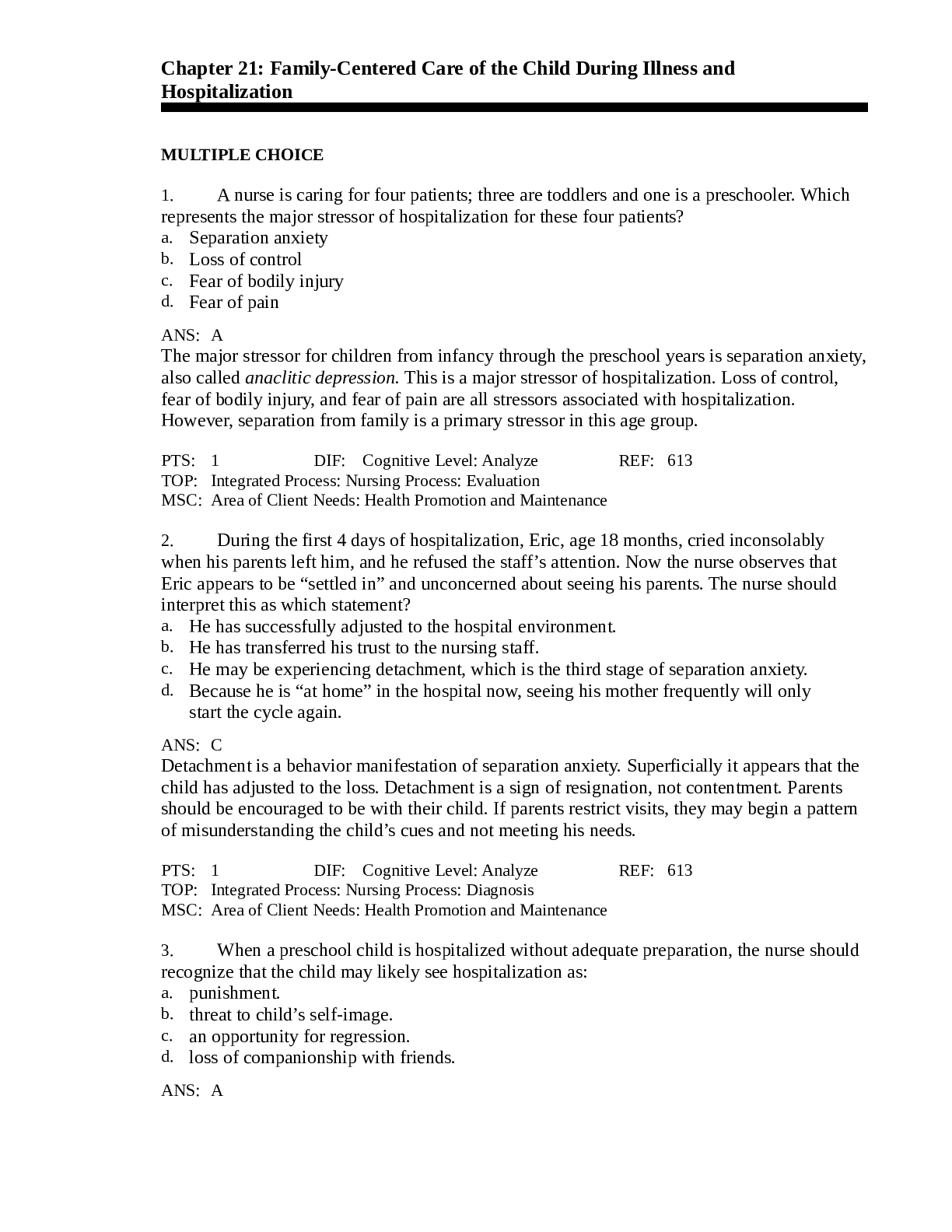


.png)




